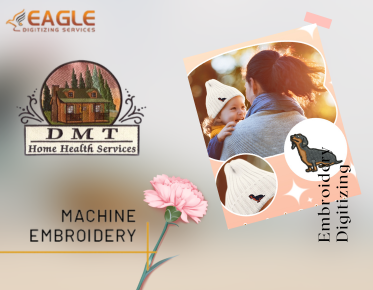Quick Steps to Digitize a Logo for Embroidery Like a Pro
Turning a logo
into a format suitable for embroidery is essential for achieving a
high-quality, professional look on fabric. Digitizing involves converting your
logo into stitches that an embroidery machine can read and execute. In this
article, we'll guide you through the key steps, from preparing the image file
to setting the right stitch types and density. With these tips, you'll be able
to transform any logo into a crisp, eye-catching embroiderydesign.
Preparing Your Logo for Digitization
Choosing
the Right Format for Your Logo
Before diving
into the digitization process, it's vital to select the right file format for
your logo. Vector formats, such as EPS, AI, or SVG, are preferred because they
maintain the quality of the design when resized. Raster images like JPGs or
PNGs can be used but may lose detail when scaled up, making it harder for the
digitizing software to convert the design into stitches without distortions.
Simplifying
Complex Logos for Better Embroidery Results
Not all logos are
created equal when it comes to embroidery. Complex logos with fine details,
intricate lines, or small text might not translate well onto fabric.
Simplifying these elements—by reducing the number of colors or simplifying text
and lines—can lead to cleaner, more effective embroidery. Remember, less is
often more when it comes to logo digitization forembroidery.
How
to Ensure Your Logo is Embroidery-Friendly
Embroidery
requires certain adjustments to make your logo work well on fabric. Avoid
extremely thin lines or excessive detailing, as they may not stitch out
properly. Opt for solid, bold shapes and ensure your text is large enough to be
legible. It's also important to consider the scale of the design and the fabric
type to avoid distortion during stitching.
Importing Your Logo into the Digitizing Software
File
Formats That Work Best for Importing Logos
When importing
your logo into embroidery software, vector file formats such as AI, EPS, or SVG
are ideal because they maintain crisp lines and scalable features. However, if
you're working with a raster image like a JPG or PNG, you may need to convert
it to a vector format first using the software's trace tool.
How
to Clean and Prepare Your Logo for the Software
Before importing,
it’s crucial to clean up your logo in a vector-editing program (like Adobe
Illustrator) to ensure smooth lines and eliminate any extraneous elements. This
step prevents unnecessary complications in the digitization process and ensures
your design will translate well into stitches.
Using
Image Trace and Vectorizing Tools for Cleaner Edges
Most embroidery
software includes image tracing or vectorizing tools that can automatically
convert raster images into vector files. These tools clean up edges, simplify
shapes, and help prepare the logo for digitization, giving you a much more
refined starting point for stitching.
Converting Your Logo into
Stitches
How
to Choose the Right Stitch Types for Your Logo
Once your logo is
in the software, it’s time to convert it into stitches. Choosing the correct
stitch type—whether satin stitches for outlines, fill stitches for solid areas,
or running stitches for fine details—depends on the logo’s complexity and
design. Each stitch type offers a different texture and effect on the fabric.
Understanding
Satin, Fill, and Running Stitches
●
Satin Stitches: Best for narrow areas, creating a
sleek, shiny look. Often used for borders and text.
●
Fill Stitches: Ideal for larger areas, providing
solid coverage with a textured appearance.
●
Running Stitches: Typically used for outlines or
finer details, offering a lighter, less dense stitch.
Adjusting
Stitch Density for the Best Results
The density of
your stitches directly impacts the final look and feel of your embroidery. Too
dense, and the fabric may pucker; too sparse, and the design may look
incomplete. Adjusting the stitch density based on fabric type and logo detail
is key to achieving a high-quality, professional result.
Setting the Right Stitch Path
for Your Logo
Planning
the Stitching Order to Avoid Thread Cuts and Jumps
The stitching order is crucial for a clean, efficient
embroidery process. By planning the order in which stitches are made, you can
avoid unnecessary thread cuts and jumps that may disrupt the overall design.
Generally, the machine should start stitching from the smallest or most
detailed areas and work toward the larger, simpler parts of the design.
How
to Avoid Overlapping Stitches and Maintain Quality
Overlapping
stitches can lead to bulky areas and cause thread bunching, which impacts the
quality of the final design. To avoid this, ensure that each stitch type is applied
in a way that minimizes overlap, especially in areas with intricate detailing.
Creating
Seamless Transitions Between Different Parts of the Logo
Seamless
transitions between different sections of the logo help maintain the design’s
integrity. For example, when moving from one color to another, it’s essential
to control the stitch path so that the transition doesn’t create any unwanted
gaps or thread tension issues.
Choosing the Right Thread Color for Embroidery
Matching
Thread Colors to Your Logo’s Design
Accurate thread
color matching is vital for ensuring the embroidered logo closely resembles its
digital counterpart. While embroidery thread color may not always exactly match
screen colors, you can closely match Pantone colors with available thread
options. Make sure to choose high-quality threads that are durable and vibrant.
The
Importance of Color Contrast in Embroidery
Contrast plays a
significant role in making the design stand out. High contrast between
background and logo colors ensures that your design is bold and visible from a
distance. When choosing thread colors, ensure they provide enough contrast to
make each logo element distinct.
Tips
for Managing Multi-Color Designs
If your logo
features multiple colors, break the design into manageable sections based on
thread color. This process ensures that the machine changes thread color
efficiently and accurately, minimizing downtime and enhancing the production
process.
Adjusting Size and Proportions for Embroidery
How
to Scale Your Logo Without Losing Quality
Scaling your logo
to fit different fabrics or products requires careful consideration. Enlarging
a design too much can distort it, while scaling it down might cause details to
become unreadable. Use vector-based software to ensure that resizing the logo
does not compromise its clarity or precision.
Finding
the Ideal Size for Different Fabric Types
Not all fabrics
are created equal, and the right size for one material might not be ideal for
another. For example, a logo on a small shirt pocket should be smaller and more
detailed, while the same logo on a large tote bag may be scaled up to maintain
impact and legibility.
Testing
Your Design on a Small Sample First
Always test your
design on a small piece of fabric before committing to a full production run.
This helps you assess how the logo looks when stitched and allows you to make
any necessary adjustments to size, stitch density, or color before proceeding
with the full batch.
Compensating for Fabric Type and Stitch Type
How
Different Fabrics Affect Your Logo’s Final Look
The type of
fabric used can significantly influence the final embroidery result. For
example, a soft fabric like cotton may absorb thread more easily, while a
stiffer material like denim might make the stitches appear raised or uneven.
Understanding fabric behavior is key to ensuring your design looks great no
matter what it’s embroidered on.
Adapting
Your Logo Design to Fit Different Textile Materials
Each fabric type
may require subtle tweaks to your design. For example, when embroidering on
stretchy fabrics, you may need to adjust the tension or choose a more flexible
stitch type to ensure the logo remains intact. Pay attention to how different
materials interact with your design to achieve the best results.
Tips
for Embroidering on Challenging Fabrics
Embroidery on
challenging fabrics, such as leather or heavy canvas, requires special
attention. Ensure your machine settings are adjusted for the material, and
consider using stabilizers to prevent fabric distortion. Additionally, heavier
fabrics may require thicker thread for better coverage and durability.
Previewing Your Digitized Logo Design
Why
You Should Always Preview Your Design Before Going Live
Before sending
your design to the machine, always preview it in the digitizing software. This
will allow you to spot any issues that might arise, such as misaligned stitches
or color mismatches, allowing you to make corrections before the final stitch.
How
to Use the Stitch Simulation Feature to Spot Problems Early
Many embroidery
software programs offer a stitch simulation feature, which lets you preview how
the design will look once embroidered. This can be invaluable in detecting
problems like thread breaks, stitch overlap, or poor design alignment. Make
sure to use this feature to catch any issues early.
What
to Do if Your Preview Doesn't Match Your Expectations
If your preview
doesn’t match your expectations, go back and recheck the stitch paths, colors,
or thread types. The issue may be related to improper stitch direction,
incorrect thread settings, or even fabric choice. Fine-tuning the design in the
software will ensure that your preview accurately represents the finished
product.
Testing Your Design with a Sample Stitch-Out
The
Importance of Running a Test Stitch for Accuracy
Before committing
to a full batch of embroidery, always run a test stitch-out. This gives you the
chance to check for any flaws in the design, such as thread breaks or color
inconsistencies, and allows you to make any final adjustments before the real
job begins.
How
to Prepare Your Embroidery Machine for the First Test
Proper
preparation of your embroidery machine is
crucial for the test stitch. Make sure the machine is threaded correctly, the
fabric is set up properly, and the design is loaded into the machine’s software.
Choose a fabric similar to what you'll be using for the final product.
Troubleshooting
Common Issues After a Test Run
If the test
stitch doesn’t go as planned, troubleshoot the issue by checking the thread
tension, needle type, and fabric placement. Common issues include uneven
stitches, thread breaks, or fabric puckering. Address these problems and rerun
the test stitch until everything runs smoothly.
Exporting Your Design for the Embroidery Machine
What
File Formats Do You Need to Export Your Design?
Once you’re
satisfied with your design, export it in the appropriate file format for your
embroidery machine. Common formats include DST, PES, and JEF. Ensure the format
is compatible with the machine’s software, as not all machines support every
format.
How
to Save Your Design for Different Types of Machines
If you plan to
use multiple embroidery machines, save your design in different formats that
are compatible with each machine. This ensures that you can use the same design
across different equipment without compatibility issues.
Organizing
Your Files for Easy Access and Future Use
Create a
well-organized file system to store your designs. Label files clearly with the
machine type, design name, and creation date. This will make it easier to find
and reuse your designs later on.
Digitizing a logofor embroidery is both a technical and creative process. By understanding the nuances of file formats, stitch types, and fabric compatibility, you can create a polished, professional design that looks fantastic on any garment or product. With patience and practice, mastering the art of logo digitization will unlock endless possibilities for beautiful, high-quality embroidery projects.



